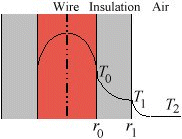Heat Transfer Problem :
Maximum current in an electric wire
Problem.
An electric wire with radius r0 of 0.5 mm is made of copper [electrical conductivity = 5.1 x 107 ohm-1 m-1 and thermal conductivity = 380 W/(m K)]. It is insulated (see figure) to an outer radius r1 of 1.5 mm with plastic [thermal conductivity = 0.35 W/(m K)].

Figure. Heating of an insulated electric wire.
The ambient air is at 38oC and the heat transfer coefficient from the outer insulated surface to the surrounding air is 8.5 W/(m2 K). Determine the maximum current in amperes that can flow at steady-state in the wire without any portion of the insulation getting heated above its maximum allowable temperature of 93oC.
Solution.
In general, the heat flow is given by Q = ![]() T/Rth,
where
T/Rth,
where ![]() T is the temperature driving force (thermal potential difference).
The thermal resistance for a cylindrical annulus is Rth = ln (r1/r0)/(2
T is the temperature driving force (thermal potential difference).
The thermal resistance for a cylindrical annulus is Rth = ln (r1/r0)/(2![]() kL) and the thermal resistance for a fluid film at a solid-fluid interface is Rth = 1/(hA). Here, k is the thermal conductivity, h is the heat transfer coefficient and A is the surface area for convection.
kL) and the thermal resistance for a fluid film at a solid-fluid interface is Rth = 1/(hA). Here, k is the thermal conductivity, h is the heat transfer coefficient and A is the surface area for convection.
The thermal resistances for the insulation and air film are in series as shown in the figure below.
Figure. Thermal resistance representation of insulation and air film.
Based on the above thermal resistance representation, the heat flow is
| (1) |
where k is the thermal conductivity of the plastic insulation.